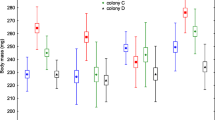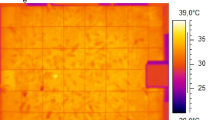Abstract
In addition to honeybee workers, drones also contribute to colonial thermoregulation. We show the drones’ contribution to thermoregulation at 5 different experimental temperatures ranging from 15– 34 °C. The frequency and the degree of endothermy depended on the drones’ local ambient temperature and age. Location on brood or non-brood areas had no influence. The frequency of endothermic drones and the intensity of endothermy increased with decreasing temperature. 30% of drones of 8 days and older heated their thorax by more than 1 °C above the abdomen. The youngest drones (0–2 days) did not exceed this level of endothermy. Though young drones were less often engaged in active heat production, their contribution to brood warming was not insignificant because their abundance on the brood nest was 3.5 times higher than that of the oldest drones (⩾13 days). Results suggest that the stimulus for the drones’ increased frequency of heating at low experimental temperatures was their low local ambient air and/or comb temperature.
Zusammenfassung
Honigbienen sind bekannt für ihre Fähigkeit zur Endothermie, die sie u. a. dafür nutzen, die Brutnesttemperatur in einem Bereich zwischen 32– 36 °C konstant zu halten. Diese Aufgabe wird im Wesentlichen von den Arbeiterinnen übernommen. Ziel dieser Untersuchung war zu klären, ob auch die Drohnen einen Beitrag zur kolonialen Thermoregulation leisten und ob dabei eine Altersabhängigkeit festgestellt werden kann.
Dafür wurden frisch geschlüpfte Drohnen mit Farbpunkten an Thorax und Abdomen markiert und anschließend einem Beobachtungs stock, der mit einem brütenden Volk besetzt war, zugesetzt. Dieser war auf beiden Seiten mit einer Infrarot durchlässigen Folie ausgestattet, sodaß mit einer Thermografiekamera die Körpertemperatur der Bienen und die Temperatur der Wabenoberfläche gemessen werden konnte. Der Beobachtungs stock befand sich in einem klimatisierten Raum, in dem die Versuche bei 5 verschiedenen experimentellen Temperaturen zwischen 15–34 °C durchgeführt wurden. Als Maß für die Heizstärke oder Heizleistung der Drohnen wurde die Temperaturdifferenz zwischen Thorax und Abdomen, bzw. Wabe oder umgebender Luft gewählt. Während den Messungen wurde die Position auf den Waben bestimmt, der Zellinhalt ermittelt und die umgebende Lufttemperatur gemessen.
Drohnen waren seltener am Brutnest anzutreffen als Arbeiterinnen. Ihre Aufenthaltshäufigkeit am Brutnest sank von 27,1 % im Alter von 0–2 d auf 7,8 % im Alter von ⩾ 13 d ab. Bei den Arbeiterinnen nahm die Häufigkeit viel stärker ab, von 72,6 % auf 27,7 % (Abb. 2). Bei unseren Versuchen beteiligten sich die Drohnen auch an der kolonialen Thermoregulation. Dieses Ergebnis wurde vor allem bei niedrigen Versuchstemperaturen, d.h. bei starker thermischer Belastung, sichtbar. Bei den Experimenten mit 15 °C zeigten sie die stärkste Heizleistung, wobei hier eine klare Altersabhängigkeit ersichtlich wurde (Abb. 3–5). Drohnen ab dem Alter von 8 Tagen heizten häufiger (30–42 %, Fig. 4) und stärker als die beiden jüngeren Altersgruppen (0–12 %, Abb. 4). Dieses Ergebnis läßt sich daraus erklären, daß junge Drohnen (< 2 Tage) die Fähigkeit zur Wärmeproduktion wahrscheinlich noch nicht voll entwickelt haben, wie wir bei Arbeiterinnen bereits feststellen konnten.
Die relative Häufigkeit heizender Drohnen war mit einer Ausnahme (15 °C) auf der Brut und auf brutfreien Wabenflächen gleich (Abb. 4, Inserts). Bei den Versuchen mit 15 °C heizten vor allem die älteren Drohnen (> 2 Tage) in den kälteren, peripheren brutfreien Bereichen stärker. Die Ergebnisse einer ANCOVA und Korrelationsanalyse zeigten, daß nicht der Wabeninhalt (Brut), sondern die Waben- und/oder lokale Lufttemperatur das thermische Verhalten der Tiere bestimmte. Diese Ergebnisse weisen darauf hin, daß die Drohnen nicht wie die Arbeiterinnen durch die Anwesenheit von Brut zum Heizen stimuliert wurden, sondern daß sie nur zu ihrem eigenen Wohlbefinden die Körpertemperatur erhöhten, und um ein Absinken ihrer Umgebungstemperatur zu verhindern. Trotzdem tragen sie durch ihre gegenüber einer Arbeiterin wesentlich größere Körpermasse nicht unbedeutend zur kolonialen Thermoregulation bei.
Similar content being viewed by others
References
Bonsels W. (1912) Die Biene Maja und ihre Abenteuer. Ein Roman für Kinder, 1.–3. Auflage, Berlin, Leipzig, 1912. 8°, 178 S.
Büdel A. (1955) Schwankungen der Lufttemperatur in der Wabengasse eines brütenden Bienenvolkes, Z. Bienenforsch. 3, 88–92.
Büdel A. (1960) Bienenphysik, in: Büdel A., Herold E. (Eds.), Biene und Bienenzucht, Munich: Ehrenwirth.
Bujok B., Kleinhenz M., Fuchs S., Tautz J. (2002) Hot spots in the bee hive, Naturwissenschaften 89, 299–301.
Currie R.W. (1987) The biology and behaviour of drones, Bee World 68, 129–143.
Fahrenholz L., Lamprecht I., Schricker B. (1989) Thermal investigations of a honey bee colony: thermoregulation of the hive during summer and winter and heat production of members of different bee castes, J. Comp. Physiol. B 159, 551–560.
Fahrenholz L., Lamprecht I., Schricker B. (1992) Calorimetric investigations of the different bee castes of honey bees, Apis mellifera carnica, J. Comp. Physiol. B 162, 119–130.
Gates V. (1914) The temperature of the bee-colony, Bull. US. Dept. Agric. 96.
Gmeinbauer R., Crailsheim K. (1993) Glucose Utilization During Flight of Honeybee (Apis mellifera) Workers, Drones and Queens, J. Insect. Physiol. 39, 959–967.
Goller F., Esch H.E. (1990) Muscle potentials and temperature acclimation and acclimatization in flight muscles of workers and drones of Apis mellifera, J. Therm. Biol. 15, 307–312.
Goller F., Esch H.E. (1991) Oxygen consumption and flight muscle activity during heating in workers and drones of Apis mellifera, J. Comp. Physiol. B 161, 61–67.
Graham S., Myerscough M.R., Jones J.C., Oldroyd B.P. (2006) Modelling the role of intracolonial genetic diversity on regulation of brood temperature in honey bee (Apis mellifera L.) colonies, Insect. Soc. 53, 226–232.
Groh C., Tautz J., Rossler W. (2004) Synaptic organization in the adult honey-bee brain is influenced by brood-temperature control during pupal development, Proc. Natl. Acad. Sci. USA 101, 4268–4273.
Groh C., Ahrens D., Rossler W. (2006) Environment- and age-dependent plasticity of synaptic complexes in the mushroom bodies of honeybee queens, Brain Behav. Evol. 68, 1–14.
Harrison J.M. (1987) Roles of individual honeybee workers and drones in colonial thermogenesis, J. Exp. Biol. 129, 53–61.
Hess W.R. (1926) Die Temperaturregulation im Bienenvolk, Z. Vgl. Physiol. 4, 465–487.
Himmer A. (1932) Die Temperaturverhältnisse bei den sozialen Hymenopteren, Biol. Rev. 7, 224–253.
Jones C.J., Helliwell P., Beekman M., Maleszka R., Oldroyd B.P. (2005) The effects of rearing temperature on developmental stability and learning and memory in the honeybee, Apis mellifera, J. Comp. Physiol. A 191, 1121–1129.
Kleinhenz M., Bujok B., Fuchs S., Tautz J. (2003) Hot bees in empty broodnest cells: heating from within, J. Exp. Biol. 206, 4217–4231.
Koeniger N. (1978) Das Wärmen der Brut bei der Honigbiene (Apis mellifera L.), Apidologie 9, 305–320.
Kovac H., Stabentheiner A. (1999) Effect of food quality on the body temperature of wasps (Vespula vulgaris), J. Insect Physiol. 45, 183–190.
Kovac H., Stabentheiner A. (2004) Thermografische Messung der Körpertemperatur von abfliegenden und landenden Drohnen und Arbeiterinnen (Apis mellifera carnica Pollm.) am Nesteingang, Mitt. Dtsch. Ges. Allg. Angew. Entomol. 14, 463–466.
Kovac H., Stabentheiner A., Hetz S.K., Petz M., Crailsheim K. (2007) Respiration of resting honeybees, J. Insect Physiol. 53, 1250–1261.
Kronenberg F., Heller C. (1982) Colonial Thermoregulation in Honey Bees (Apis mellifera), J. Comp. Physiol. 148, 65–76.
Sachs L. (1997) Angewandte Statistik. Springer, Berlin, Heidelberg, New York.
Seeley T.D. (1985) Honeybee Ecology: A Study of Adaptation in Social Life, Princeton Univ. Press, Princeton.
Simpson J. (1961) Nest climate regulation in honey bee colonies, Science 133, 1327–1333.
Stabentheiner A., Schmaranzer S. (1987) Thermographic Determination of Body Temperatures in Honey Bees and Hornets: Calibration and Applications, Thermology 2, 563–572.
Stabentheiner A., Kovac H. (2002) Beitrag unterschiedlich alter Arbeiterinnen zur Wärmeproduktion im Brutnest von Bienenvölkern, Apidologie 33, 499–500.
Stabentheiner A., Kovac H., Schmaranzer S. (2007) Thermal Behaviour of Honeybees During Aggressive Interactions, Ethology 113, 995–1006.
Tautz J., Maier S., Groh C., Roessler W., Brockmann A. (2003) Behavioral performance in adult honey bees is influenced by the temperature experienced during their pupal development, Proc. Natl. Acad. Sci. USA 100, 7343–7347.
Vollmann J., Stabentheiner A., Kovac H. (2004) Die Entwicklung der Endothermie bei Honigbienen (Apis mellifera carnica Pollm.), Mitt. Dtsch. Ges. Allg. Angew. Entomol. 467–470.
Author information
Authors and Affiliations
Corresponding author
Additional information
Manuscript editor: Klaus Hartfelder
Rights and permissions
About this article
Cite this article
Kovac, H., Stabentheiner, A. & Brodschneider, R. Contribution of honeybee drones of different age to colonial thermoregulation. Apidologie 40, 82–95 (2009). https://doi.org/10.1051/apido/2008069
Received:
Revised:
Accepted:
Issue Date:
DOI: https://doi.org/10.1051/apido/2008069




